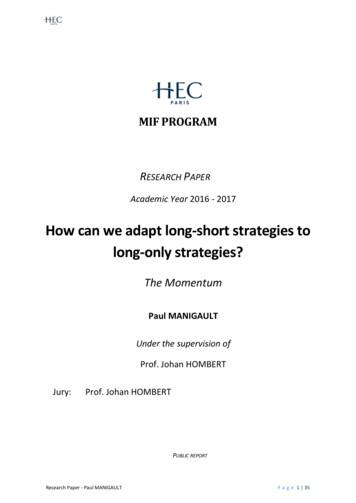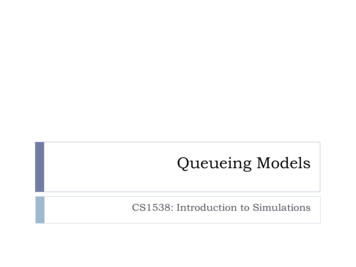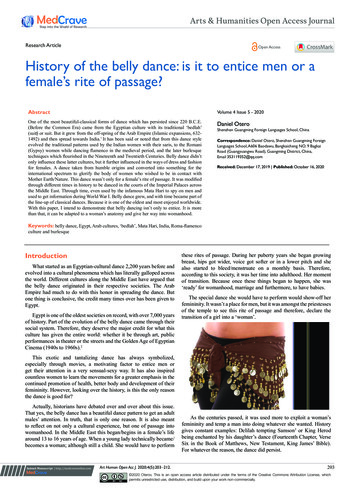
Transcription
MIF PROGRAMRESEARCH PAPERAcademic Year 2016 - 2017How can we adapt long-short strategies tolong-only strategies?The MomentumPaul MANIGAULTUnder the supervision ofProf. Johan HOMBERTJury:Prof. Johan HOMBERTPUBLIC REPORTResearch Paper - Paul MANIGAULTP a g e 1 35
SummaryAbstract . 3Introduction . 4I)The momentum strategy: definition, rational, methodology and performance according tothe literature . 5A)Definition and rational of the momentum strategy .5B)Performance and robustness of this trading strategy .6C) Our objective: validate those academic studies with different set of data and implement alsoa long-only strategy .7II)Implementing the momentum strategy for both a long-short and long-only portfolio . 8A)Our methodology for data collection and portfolio construction: .8B)Results for the long-short portfolios and the long-only portfolio . 10Back-testing of the strategy for the CAC 40.10Back-testing of the strategy for the S&P 500 .15C)III)Are there any significant advantages for a given strategy? . 18Limitations of the momentum strategy and additional constraints . 19A)The impact of transaction costs.19B)The funding and short-sales constraints .20C)Absence of added value to justify for the level of fees? .21Conclusion . 23Thanks .24Bibliography . 25Annexes . 26Back-testing of the strategy for the CAC 40.26Back-testing of the strategy for the S&P 500 .31Research Paper - Paul MANIGAULTP a g e 2 35
AbstractThe aim of this research paper is to test the replicability of the momentum strategy for along-only investor. After reviewing the academic literature on the momentum effect and itsrationale, we will detail our methodology to build portfolios with long-only and long-shortmomentum strategies on the CAC 40 and the S&P 500. The main contribution of this researchpaper is to figure out if a long-only investor can obtain the same performances as a lessconstraintinvestor.Research Paper - Paul MANIGAULTP a g e 3 35
IntroductionWe will focus on only one defined trading strategy: the momentum which consists inbuying the “winners” over the last 12 months and shorting the losers. The main focus of thisresearch paper is to test the ability for a constrained investor (let’s say a mutual fund with noaccess to leverage and to short-selling) to replicate the momentum strategy. We willcompare the risk-adjusted performance and the absolute performance of the two strategies(long-short versus long-only strategy). We will look carefully at the behaviour of the longonly portfolio during a market crash and more generally we will look at the main indicatorsfor risks (maximum drawdown, volatility, Sharpe ratio, skewness, and kurtosis).First I will present a review of the academic literature for the momentum strategy. Then,the major part of the research paper will be composed of several portfolio constructions withreview of the performances. To do so, we have downloaded and sort stock prices data on amonthly basis for the CAC 40 and the S&P 500 over a long-period of time (15 and 20 yearsrespectively). We will explain in details the challenges that should be overcome to build themomentum strategies and we will try to figure out the potential advantages and drawbacksof the long-only strategy. Instead of adopting a binary vision (long-only investor versus longshort investor) we will also try to test long-short strategies with different market exposure.To conclude we will also present the limitations of our portfolio constructions such as theabsence of transaction costs or short-sales constraints.Research Paper - Paul MANIGAULTP a g e 4 35
I) The momentum strategy: definition, rational, methodology andperformance according to the literatureA) Definition and rational of the momentum strategyThe momentum strategy consists in buying stocks that have outperformed recently(“winners”) and shorting stocks that have underperformed. Usually practitioners andacademics consider the performance over the past 12 months to sort the stocks betweenwinners and losers. By definition, the momentum is a trend-following strategy and theunderlying assumption is that a stock that have overperformed or outperformed the last 12months will tend to follow the same trend the following month. While historically, themomentum strategy has been implemented for single stocks, many studies have also provena momentum effect for other financial assets (bonds, indices, commodities, forex) across theworld. In this research paper, we will only discuss and implement the momentum strategy forsingle stocks including in major European and American indices. However, it is worthy tonote that our different strategies can be tested and implemented with the samemethodology for different asset classes.If the mechanism of this trend-following strategy is very easy to understand, it is muchharder to explain its rational. First, we can stress that this trend-following strategy is incontradiction with the weak form of the Efficient Market Hypothesis stipulating that onecannot predict future stock returns from past returns. Indeed, according to Eugene Fama(1970) the current stock prices should reflect all the available information. Thus, in thecontext of Efficient Market Hypothesis the momentum strategy lacks from theoreticalground. To a certain extent, the momentum strategy seems similar to a chart analysis basedon Wall Street maxims such as “The trend is your friend”, “Don’t fight the tape”. Themomentum strategy is also counter-intuitive for value investors like Graham and Buffet whodo not believe in market efficiency. For them, there are persistent discrepancies between themarket prices and the intrinsic value of the companies which correspond to the “true” valueof the stocks. As the momentum strategy only looks at price changes over the past 12months, this strategy makes no sense since it does not take into account the fundamentaldata of the companies.So how can we explain the rational of the momentum strategy? In Efficiently Inefficient,2015, Pedersen has shown the theoretical difficulty to explain the performance of themomentum strategy using a risk premium. The momentum is a very active strategy with ahigh turnover since we rebalance frequently our portfolio depending on the relative priceschanges over the past 12 months. As a result, if we explain the momentum for a single stockwith a rational risk premium this premium will significantly vary over a short period of time.On a theoretical standpoint, it is hard to figure out why the stock’s risk should be so volatile.Pedersen suggests another explanation for momentum linked to markets inefficiency: ingeneral investors initially underreact after good news and then overreact which creates themomentum. To explain this idea that can be counterintuitive, let’s take the case of acompany that just released its annual results and suppose they are above the marketexpectations. Initially the momentum is produced when there is an underreaction of theResearch Paper - Paul MANIGAULTP a g e 5 35
market after this good news: the price increase but it should continue to go up in the futureto price correctly this information. Then, if prices are going up for several months,opportunistic investors will look at the company and start buying the stock: this delayedoverreaction will add to the momentum.Another explanation for momentum is given by behavioural finance. Even if they do notmention specifically the momentum, Shefrin and Statman demonstrate some psychologicalbiases in “The Disposition to Sell Winners Too Early and Ride Losers Too Long: Theory andEvidence” (1985). One part of their findings deals with aversion to loss realization, apsychological bias that has been highlighted before by Kahneman and Tversky. Shefrin andStatman find empirical and theoretical evidence to illustrate that more generally, investorstend to realise their profits as soon as possible by selling the stocks that go up in order torealise a profit. However, investors stick to losers: even if the prices go down in general thereis a strong psychological bias to hold the stocks hoping for a mean-reversion. Their findingcould be a good behavioural explanation for the momentum. For instance, if a companydelivers annual results higher than expected, the price will go up immediately but there is anunderreaction due to an important selling pressure from investors willing to realise theirgains. This is a well-known trend in financial markets and this psychological bias is usuallyreferred as “profit taking”.However, we should stress that there is no single and valid explanation for themomentum strategy. Its abnormal positive risk-adjusted return is still a puzzle since itpersists over time while being one the most known price anomaly effect. As we will see in thenext paragraph, the high exposure of the momentum strategy to market crash can be anexplanation for the persistence of this anomaly: while on average it generates high-excessreturn, it has a very negative skewness.B) Performance and robustness of this trading strategyAs the momentum strategy is a quantitative strategy based only on the relative stockprices returns over the past 12 months, this is a strategy easy to replicate and manyacademic studies point out its performance. Despite its relative simplicity, Barroso and SantaClara (2015) find that the momentum strategy offers the highest Sharpe ratio compared tothe other factors of the Fama-French model (value, market, size). They use monthly returnsover a very-long time period from July 1926 to December 2011 using the Kenneth Frenchdata library. For the construction of the momentum portfolios, stocks are ranked and sortedinto deciles in function of their return from month m-12 to m-2. By convention, in theacademic literature the past month m-1 is excluded to classify the stock performance. Indeedit could be a way to avoid mean-reversion for stock returns that can occur in the last monthm-1. The Winner-Minus-Loser strategy is constructed by taking a long position in the highestdecile corresponding to winner stocks and a shot position in the lowest decile correspondingto “losers” stocks.As we can see in the below table, according to the study of Barroso and Santa-Clara(2015), with a Sharpe ratio of 0.53, the momentum exceeds by far the other strategies basedon the 3 Fama-French factors (market for RMRF, size for SMB and value for HML). Should weResearch Paper - Paul MANIGAULTP a g e 6 35
deduce that the momentum is the best trading strategy? This is also the most volatilestrategy with a standard deviation of 27.53% and a very high negative skewness of -2.47. Themomentum strategy is also subject to the worst drawdown among the difference factors.Indeed by construction the momentum strategy is trend-following so it is more exposed tomarket crashes. The rationale is quite intuitive: on one side we are long the stocks that haveoutperformed the most over the last rolling 12 months. We can stipulate that the marketshave high expectations for the performance of those stocks and they are more likely to godown significantly during a market crash. On the other side, we are short the stocks thathave outperformed significantly over the past 12 months and if there is a significant reversaland rebound in stock markets, we will also lose on the short leg of our portfolio.Findings of Barroso and Santa-Clara. Long-term performance for the different factors withsample returns from 1927 to 2011:C) Our objective: validate those academic studies with different set ofdata and implement also a long-only strategyThe momentum strategy has been implemented and back-tested by various academicand professionals not only for equities but also for bonds, commodities and currencies fordifferent geographic areas. As we have seen above this strategy has produced a positive riskadjusted return over time. While the momentum strategy has been usually implemented byacademics for a long-short portfolio, this does not take into account the constraints faced bymany fund managers: limited leverage, no ability to short-sell (constraint for the vastmajority of regulated mutual funds), investors want to have a long-only exposure. Thus ourresearch paper will try to bring another perspective by building both a long-short and a longonly trading strategy based on the momentum for different stock indices. We will comparethe performance of those two strategies but also the risk-adjusted performance and thedifferent risk measures (volatility, Sharpe ratio, maximum drawdown, % of months withnegative performance, skewness, and kurtosis). It is very important to have this comparisonsince the purpose of implementing a long-short strategy is to minimise the volatility and thelosses in case of market crash. As the expectations for markets returns are positive due tothe positive risk premium for equities so one investor tends more naturally to be long-only.Another objective of this research paper is to identify the practical and theoretical issuesthat a fund manager may encounter when he will try to implement a momentum strategy.Indeed, in case someone wants to continue this work for a different set of data or implementour long-only strategy, we will detail our methodology from data collection to portfolioconstruction, and the issues that we have encountered.Research Paper - Paul MANIGAULTP a g e 7 35
II) Implementing the momentum strategy for both a long-short andlong-only portfolioA) Our methodology for data collection and portfolio construction:To test the momentum strategy for different portfolios, the first step is data collectionover a long-period of time, between 15 and 20 years for a given basket of stocks to smoothour results and take into account different market environments (e.g. stock market rally from2001 to 2007, Great Financial Crisis 2008-2009, Euro Sovereign Debt crisis in 2011.). Thisbasket of stocks should also be diversified enough to virtually eradicate the idiosyncratic risk.Thus we have considered large American and European Indices (S&P 500, CAC 40) but wehave taken into account their historical composition. Indeed, if we look only at the pastperformances for the stocks included in the current Indices we have two issues. The firstissue is the survivorship bias: by definition the S&P 500 includes the US stocks with the top500 market capitalisation for the current year so it excludes “losers” stocks whichoutperformed over the past years and companies that were taken over or that wentbankrupt. So a back testing of a long-short strategy versus a long-only strategy with thecurrent index will be biased in favour of the long-only portfolio. The other issue raised bytaking into account the current indices composition is the lack of data available: while dataproviders can provide easily the S&P 500 performance over the last century, very few stocksare listed for this period due to M&A activity, IPOs or bankruptcies.Thus even if it is time-consuming, we have done our data collection to take into accountthe historical composition of the indices and then create a strategy that is really tradable.Using Bloomberg, for each year t we have collected on a monthly basis the prices of theconstituents of the index at year t, between year t-1 and t 1 (we have also taken intoaccount the performance at year t 1, first month to be able to compute the performance ofour strategy). We rebalance our portfolio on a monthly basis and on a yearly basis werebalance our portfolio to take into account only the new constituents of the index. One canargue that there are still some limitations to this approach since the constituents of theindices can change more than one time per year. However, this method is the moststraightforward and provides enough consistency for stock prices data.To construct our portfolios, for each year t and for each month m we take theconstituents of the index at the beginning of the year and we compute the returns of thosestocks over the past 12 months period excluding the last month, that’s is to say to build ourportfolio at the beginning of month m we consider the returns of the stocks between monthm-12 and month m-1. Note that we follow what is done in the academic literature: indeedexcluding the performance of the last month is a way to take into account the meanreversion of stocks. By construction, we exclude from the index stocks that go public on yeart and join the index straight after since we have no price data.Then we rank the returns of the different stocks and for the long-short short portfoliowe decide to be long of the top performing stocks and to be short of the worst performingResearch Paper - Paul MANIGAULTP a g e 8 35
stocks. For the long-only portfolio, we are only long on the top performing stocks. On apractical way to implement and backtest this strategy, there are two important parametersto determine: the number of long and short positions, the targeted exposure to the market.The number of long and short positions should be large enough to eliminate orconsiderably reduce the idiosyncratic risk of a single stock. However it should also depend onthe size of our index to preserve the quality of the momentum signal. If we choose a verylarge number of positions proportionally to the size of the index, there is a risk to reduce themomentum effect. Following the academic literature we have decided to have a number n ofshort positions equal to the number of long positions. We will study in the next part theimpact of this number n given the size N of the index using different simulations. Usually inthe academic literature, n is chosen such that we are short the lowest decile and we are longthe highest decile.Once we have chosen the number of long/short positions, we need to determine thetargeted exposure to the market of our portfolio. For the long-only portfolio, by definitionwe have only a long exposure in n stocks and each stock is equally-weighted, representing1/n of our total portfolio. We could have chosen that the allocation of each-stock is notequally weighted but proportional to the performance that’s is to say to put more weight onthe top performing stock compared to the second one, then more weight on the second bestperforming stock than to the third one, etc. It would make sense but we believe that anallocation proportional to the ranking of the best performing stocks increases theidiosyncratic risk or the risk of a “wrong” signal for several stocks. The equal-weight decisionis motivated to smooth the performance of the momentum signal. We stress that the equalweighted decision is not the most common method used for the construction of themomentum strategy: academics tends to prefer value weighting in order to be closer to themarket portfolio and avoid to be exposed the size factor by having too much stocks of verysmall companies that tend to be more volatile than large firms. However, for us it makes lesssense to consider a value-weighting approach since we use two major indices (S&P 500 andCAC 40), so we only consider the largest stocks and we have a very limited exposure to thesize factor.For the long-short portfolio we have several options to consider. If we want a marketneutral exposure as it is done in the academic literature for the momentum strategy, theamount of the portfolio invested in the long positions should be equal to the one invested inthe short positions: thus the weight of each winner is 1/n and the weight of each loser is 1/n. We will test this strategy but we will also implement different strategies that are more inline with what practitioners do in hedge-funds. Indeed only a few hedge-funds have amarket-neutral exposure with a short position equal to the long position. Usually the shortposition is significantly smaller than the long-position for several reasons. First the rationaleof this strategy is that overall the equity market should deliver a positive risk-adjusted returnon the long-run to compensate investors for the risks taken. The second limitation of marketneutral trading strategy is that the brokers usually require collateral for the short positions.Thus the overall short positions should be smaller than the long positions. If we choose forinstance to have a 60% exposure to the market, the weight of each winner should be 1/n andthe weight of each loser should be -(1-60%)/n. More generally, if we target an exposure tothe market of x% with x between 0 and 100%, the weight of each winner should be 1/n andResearch Paper - Paul MANIGAULTP a g e 9 35
the weight of each loser should be -(1-x%)/n. We will test the performance of our portfoliodepending on x the targeted exposure to the market risk.Given our allocation at the beginning of each month, we compute the performance atthe end of the month. Then we start again the above process in order to determine the newportfolio allocation. We start with a portfolio value 100 and at the beginning of each monthwe reinvest the all amount of our portfolio. To compute our performance we make severalimportant assumptions. First we assume no transactions costs: we consider that we tradevery liquid stocks of 2 major indices (S&P 500, CAC 40) with marginal broker fees and priceimpact. We also exclude the Financial Transaction Tax (FTT) for the stocks of the CAC 40which represents a 0.3% tax on the purchase of French traded stocks with a marketcapitalisation over 1billion. Even if the momentum strategy is very active with a highturnover, it makes sense to exclude in our computations the FTT since our strategy can bereplicated using financial derivatives exempted of the FTT, such as CFD (Contract forDifference). Third for the performance of the long-short portfolio we assume no fundingconstraints or costs and no-short sales constraints. This assumption is not realistic sinceinstitutional investors need to pay fees to brokers in order to take short positions. During afinancial crisis, a freeze in the repo market can occur and significantly reduce the ability forinvestors to short-sales. In addition, some countries can enforce a temporary ban on shortselling during markets turmoil. We will discuss in details the potential impact of thoseassumptions in part III. It is also worth mentioning that we compute a gross performance forour strategy without considerations of management fees or taxes.B) Results for the long-short portfolio and the long-only portfolioBack-testing of the strategy for the CAC 40We decide to implement the momentum strategy first on the CAC 40. While the limitedamount of the index could create an issue by increasing the idiosyncratic risk, it also allows usto do both a quantitative and qualitative analysis. Indeed using a basket of 40 stocks makes iteasier to interpret and to find explanation for extreme moves in our strategy.We use the stock prices from January 2001 to December 2016 and we implement ourtrading strategy from January 2002 to December 2016 over a 15-year period. While we couldhave obtained better results using a longer period of time, we believe that the time frameconsidered is long enough to test the momentum strategy with different market conditions.Indeed, from 2002 to 2016 several recessions occurred (stock market downturn of 2002,Great Financial Crisis during 2008-2009, Eurozone crisis in 2011) and were followed by otherperiods of rebounds in financial markets. However, it is important to stress that the periodconsidered was characterised by many market crashes and it is reflected both on the overallperformance of the CAC 40 and of the momentum strategies. Note that due to the change ofcurrency from Franc to Euro, we were unable to find stock prices data before 2001.Research Paper - Paul MANIGAULTP a g e 10 35
First concerning the number of stocks, we have decided to move away from theconvention of the momentum strategy which consists in considering only the top and thelowest decile (that is to say 4 stocks each for the CAC 40). We have considered severaloptions for the number of stocks and 8 (meaning being long the top 20% and being short thelowest 20%) appears to be the optimal number to maximise the Sharpe ratio and minimisethe maximum drawdown. Below 8 the annualised volatility is far too important and above 8we have a lower return for the long-short portfolio. This empirical finding of considering onlythe 20% best/worst stocks has no theoretical ground. However we can try to interpret thisresult. Indeed, as the CAC 40 is a relatively small index, a portfolio consisting in only 4 stocks(top decile) will be not diversified enough and bear an important idiosyncratic risk associatedwith a very high volatility at the portfolio level. On the contrary a portfolio containing morethan 8 stocks will consider in total more than 40% of the investment universe and the qualityof the momentum signal will be impoverished. This is an ex-post result fitting to our datacollection and there is absolutely no proof that 8 is the right number in every time period.What is clear is that the number percentage of stocks used to build the momentum strategyshould not be fixed arbitrary to 10% of the best/10% of the worst. It depends on the totalnumber of stocks of the index considered. In annexes, page 30 we show the performance ofour long-short portfolio depending on the number of long/short positions. While thevolatility of the portfolio is a decreasing function of the number of positions, the relationbetween the performance and the number of positions is less clear.For now on, we will fix this number to 8 that is to say 8 short positions and 8 longpositions.We show below the comparison between the performance of the long-short momentumstrategy (0% net market exposure with a short position equal to the long position), the longonly momentum strategy (100% market exposure) and the CAC 40. Please note that theshort-only portfolio is not a momentum strategy by itself. Indeed in the financial industry noasset manager implement short-only strategy since it goes against the CAPM: as a risky asset,stocks should deliver positive returns. However, we include the results of the short-onlyportfolio to breakdown the performance of the long-only portfolio.Portfolio value at maturityAnnualised ReturnAnnualised VolatilitySharpe RatioSkewnessKurtosis% of negative monthsMaximum DrawdownLong-short portfolio100,50,0%23,1%0,0-1,68,043%-59%Long-only portfolio Short-only ,92,717,239%52%-60%-69%CAC 40105,10,3%17,6%0,0-0,50,743%-56%First, we can notice that the long-only momentum strategy which consists only in 8 longpositions outperforms considerably both the long-short portfolio and the CAC 40 with aSharpe Ratio of 0.3 compared to 0.0 for the long-short momentum and the reference index.The annualised return is significant at 5.4% compared to 0.0% for the long-short portfolio andthe CAC 40. The most striking fact is that the annualised volatility of the long-only portfolio islower than the long-short portfolio (respectively 20.1% and 23.1%). It seems paradoxicalsince the goal of a long-short strategy compared to a long-only strategy is to reduce theResearch Paper - Paul MANIGAULTP a g e 11 35
market exposure and decrease the volatility. In terms of maximum drawdown, themomentum strategy is riskier than the market (59% for the long-short portfolio compared to-56% for the CAC 40). Again we notice that the long-short momentum strategy does not bringany benefit compared to the long-only portfolio which has a similar maximum drawdown (60%). The momentum strategy seems to be quite correlated with the CAC 40 with a similarpercentage of months with negative returns (43% for the long-short portfolio and the CAC40, 39% for the long-only portfolio).The momentum strategy is characterised by a very negative skewness of -0.9 for thelong-only portfolio and even higher -1.6 for the long-short portfolio compared to a skewnessof -0.5 for the CAC 40. It means that the monthly returns of the momentum strategy show animportant asymmetry with important negative returns. The high frequency of extremer
of the long-only strategy. Instead of adopting a binary vision (long-only investor versus long-short investor) we will also try to test long-short strategies with different market exposure. To conclude we will also present the limitations of our portfolio constructions such as the absence of transaction costs or short-sales constraints.










